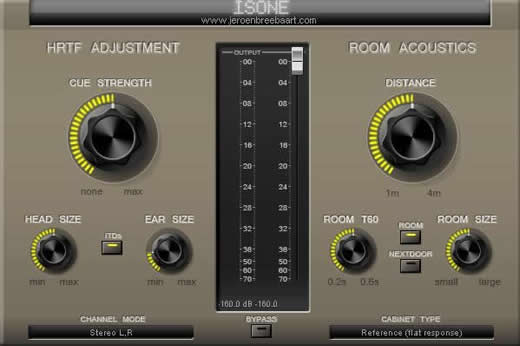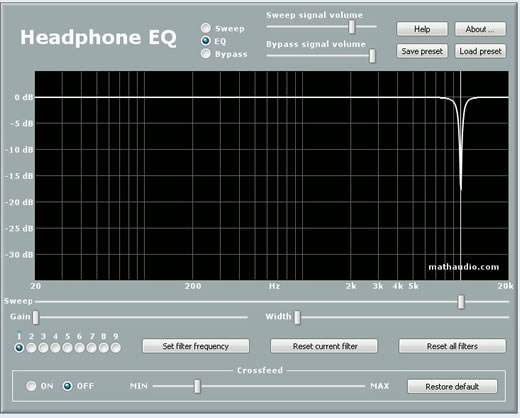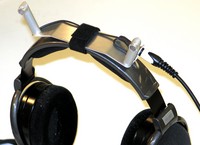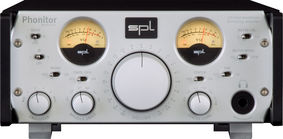- Connecting audio
- Audio PC
- Raspberry & Co
- All in Ones
- Bluetooth
- Chromecast
- Streaming audio player
- Music server
- USB Audio
- Real-time audio over IP
- FireWire DAC
- Multi-channel DAC
- NAS
- Remote control
- Vinyl rippers
- Acoustic materials
- Active crossover
- Active speakers
- Single driver speakers
- Invisible speakers
- Sound card
- Digital room correction
- Headphone
- Portable media players
Crossfeed
Using DSP one can emulate listening to speakers over a headphone by mixing the channels a bit, adding delay and even emulate the room. This is called the HRTF (Head Related Transfer Function) or crossfeed.
Benjamin B. Bauer was one of the pioneers.
A famous article by him: Stereophonic Earphones and Binaural Loudspeakers.
JAES Volume 9 Number 2 pp. 148-151; April 1961.
Your media player might have one or there is a plug-in.
A VST plug-in and a lot more about headphones can be found here: BlogOhl
ToneBoosters Isone EUR 20.00

- Zero latency processing
- Low CPU load
- Sample rate support up to 384 kHz
- Customisable HRTF's
- Customisable listening room and distance
- Wide variety of loudspeaker models
- Support for 64 bits audio data processing.
MathAudio Headphone EQ VST $60.00
A graphic equalizer and crossfeed.
You can define 9 bands by choosing a certain frequency, apply the desired gain (plus or minus) and the width of the band.

A small band allows you to compensate for resonances.

A wide band allows you to compensate for e.g. a warm midrange.
All processing is done in 64 bits.
It support sample rates from 44 to 352 kHz.
It is a VST pluging
HeaDSPeaker 5.1 Headphone Surround System

HeaDSPeaker system consists of two main parts: tracking sensors and a DSP unit.
Tracking sensors should be attached to your existing headphones.

The provided DSP unit processes the multichannel input signal and produces a dynamically auralized stereo signal for the headphones.
HeaDSPeaker is capable of decoding 5.0 multichannel signal from 2.0 stereo sources (the analog output of modern game consoles, for example).
It can also act as a 5.1 or 7.1 USB sound device when connected to a PC or Macintosh computer.
In addition the HeaDSPeaker Home version can decode Dolby Digital and DTS encoded sound from optical S/PDIF.
Connections:
- Optical S/PDIF (Dolby Digital 5.1 / DTS 5.1 / 2.0 PCM) [HeaDSPeaker Home]
- USB (7.1PCM / 5.1 PCM / 2.0 PCM)
- Analog 3.5mm stereo (2 channels stereo / 5 channel DSP-Logic active matrix decoding)
- 3.5mm stereo plug for binaural multichannel headphone output
- 3.5mm stereo plug for head-tracker (included) input
Smyth Realiser A8 USD 3,360.00

Includes Headtracking and In ear measurement
![]()
![]()

Bundled with a Stax SR-202
Sound Performance Lab - Phonitor € 1649,-
Manufacturers description:
In addition to its standard monitoring functions the Phonitor offers new controls such as “Crossfeed“, “Speaker Angle“ and “Center Level“. These are the essential parameters that create the width, balance and overall space within a listening field and how we recognize them coming from the loudspeaker. Crossfeed simulates the frequency dependent interaural level differences from both channels. Speaker Angle determines the stereo width caused by frequency dependent interaural time differences. Center Level regulates the balance between phantom centre and L/R stereo signals.
A review by Sound on Sound

